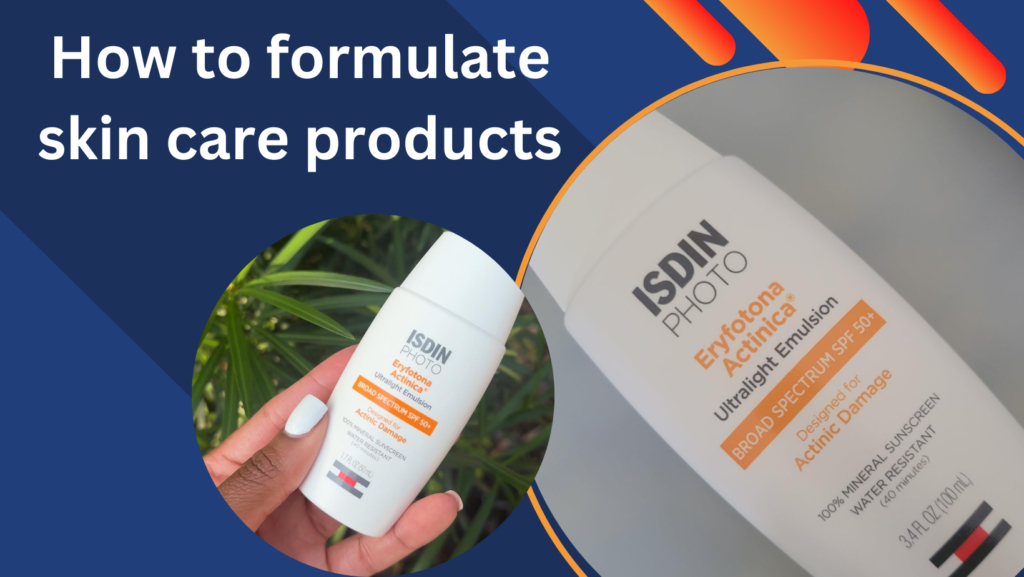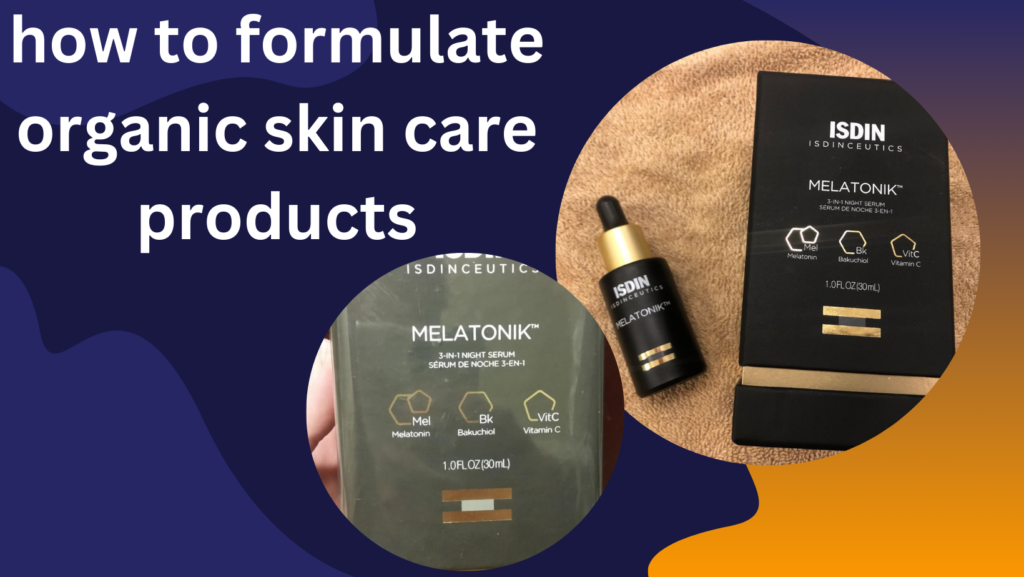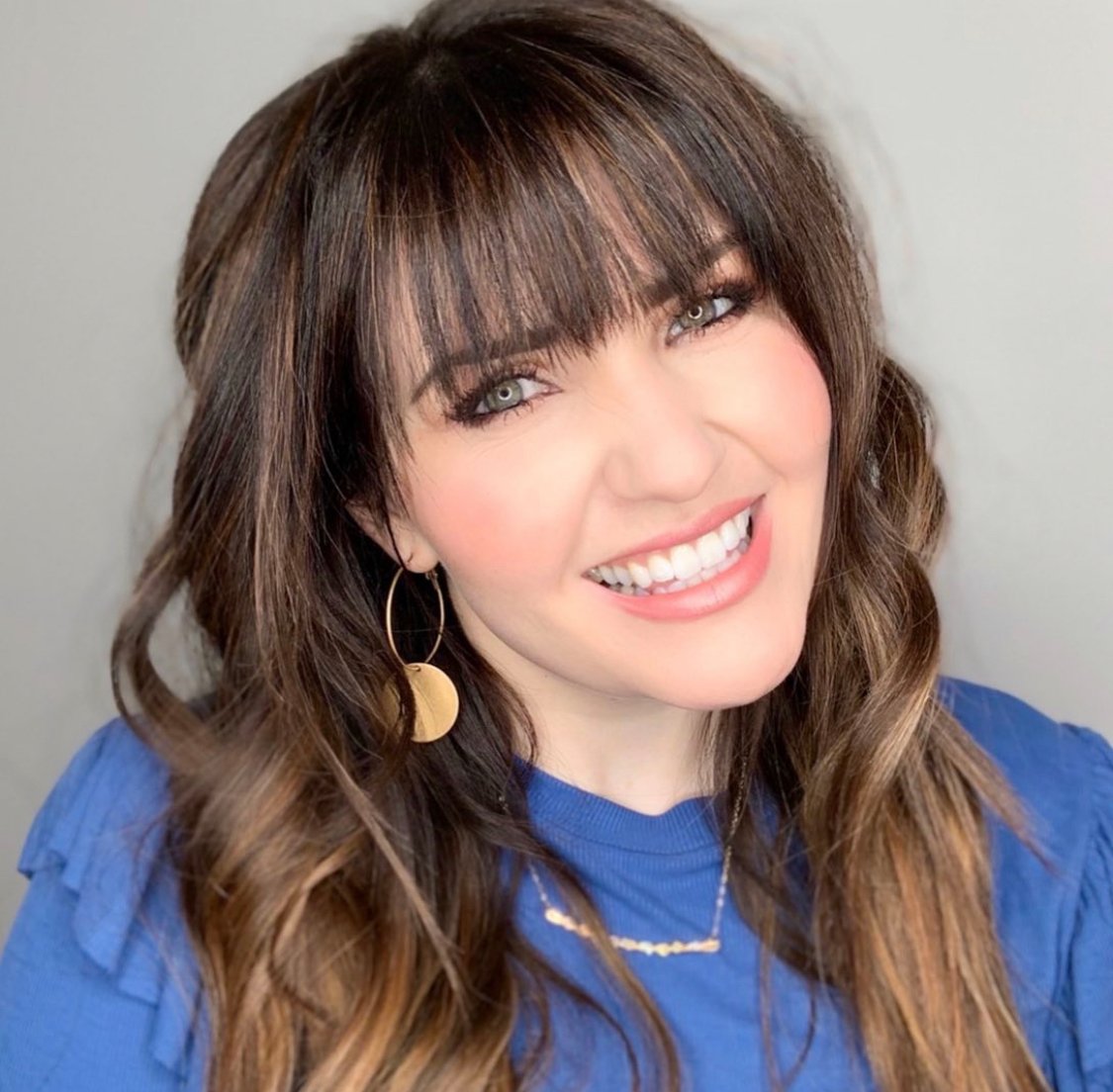Have you ever considered formulating skincare products at home? I remember my first try—mixing oils and butter, hoping to make the perfect cream. It felt tricky initially, but it all made sense once I learned the basics! I’ll show you simple steps to easily create natural and organic skin care products in this guide. Whether new or ready to level up, you’ll find everything you need here. Let’s get started!
Understanding Skin Care Formulation
Making a skin care product is like following a simple recipe. You mix the right ingredients to create something that helps the skin. Oils, water, and active ingredients work together to keep skin healthy.
There are many types of skincare products. Creams and lotions add moisture. Serums target skin issues like acne or aging. Cleansers wash away dirt, and toners refresh the skin. Each one has a job, and knowing how they work helps you make better products.
Before you start, know your skin types and concerns. Dry skin needs more moisture, oily skin needs light hydration, and sensitive skin needs gentle care. When you understand this, you can create products that truly help.
Key Ingredients in Skin Care Formulation
Have you ever checked a skincare label and felt lost? I get it! When I started, I had no clue what these ingredients did. But once I learned it, everything made sense. Let’s keep it simple!
Natural vs. Synthetic Ingredients: What’s the Difference?
Natural ingredients come from plants, minerals, or animals. Think coconut oil, aloe vera, or shea butter. They’re gentle and packed with nutrients.
Synthetic ingredients are made in labs. They last longer, work faster, and sometimes even help sensitive skin better than natural ones. Both can be great—it’s all about what your skin needs!
Must-Have Ingredients in Skin Care
✅ Emollients (Oils and butter): These keep skin soft and smooth. Shea butter, jojoba oil, and cocoa butter help lock in moisture.
✅ Humectants (Glycerin and hyaluronic Acid) pull water into your skin, keeping it plump. Hyaluronic acid is a game-changer—it holds 1000 times its weight in water!
✅ Preservatives (Natural & Synthetic Options)—No one wants spoiled products! Natural options include rosemary extract and grapefruit seed extract. Synthetic ones, like phenoxyethanol, keep things fresher and longer.
✅ Active Ingredients (Vitamins & Plant Extracts) – These power up your skincare! Vitamin C brightens, niacinamide calms, and green tea fights aging. The right mix can do wonders.
Common Irritants to Avoid
Not all natural ingredients are safe. Some essential oils, like citrus and peppermint, can be harsh. Alcohol-based products may dry out your skin. Always patch-test to be safe!
Good skincare is about balance. Mix the right ingredients, and your skin will thank you! Ready to start?

How to Formulate Natural and Organic Skin Care Products
Have you ever wondered what “natural” and “organic” mean in skincare? Many brands use these words, but they don’t always mean the same thing. Let’s break it down!
What Do “Natural” and “Organic” Mean?
- Natural means ingredients from plants, minerals, or animals that have undergone little processing. Think aloe vera, coconut oil, or shea butter.
- Organic means ingredients are grown without chemicals like pesticides or synthetic fertilizers. To be certified, they must meet strict standards.
Not all natural ingredients are organic, and not all organic products are 100% natural. Always check labels to know what you’re getting!
Choosing High-Quality, Plant-Based Ingredients
Want the best ingredients for your skin? Here’s how to find them:
Look for cold-pressed oils like jojoba or argan—they keep more nutrients.
Choose unrefined butter like shea or cocoa for deep moisture.
Pick plant-based preservatives like rosemary extract or vitamin E.
Avoid harmful additives like synthetic fragrances or parabens.
Quality matters! The fresher the ingredient, the better it works on your skin.
Step-by-Step Guide to a Simple Organic Face Cream
Making your face cream? It’s easier than you think! Here’s a basic recipe:
Ingredients:
- 2 tbsp shea butter (moisturizing)
- 1 tbsp jojoba oil (light and nourishing)
- 1 tbsp aloe vera gel (soothing)
- 5 drops lavender essential oil (calming)
Steps:
Prepare the shea butter through the double-boiler heating process.
Add jojoba oil and mix well.
Take the mixture off the heat before allowing it to cool slightly.
Stir in aloe vera and essential oil.
Whip the mixture until creamy.
Store in a clean jar and use within 3 months.
That’s it! A simple, skin-loving cream with zero harsh chemicals.
Making natural skincare is fun and rewarding. Once you start, you’ll never go back to store-bought! Ready to try it?
How to Formulate Body and Skin Care Products at Home
I had no idea where to begin when I started making my skincare products at home. It seemed like a big task, but it became much easier and fun once I learned the basics! Let me walk you through it.
Essential Tools and Equipment You’ll Need
You don’t need fancy tools, just some basics. You’ll want a good mixing bowl, a small pot for heating, and a whisk. A double-boiler setup (just a bowl over hot water) is perfect for melting ingredients without burning them. Make sure to have clean containers, like jars or bottles, ready for your products.
Basic Formulation Techniques
One of the first things I learned was how to mix oil and water. These two ingredients don’t blend independently, so you need an emulsifier—a fancy word for something that helps them stick together. Heat the oils and water separately when making a cream or lotion, then mix them while stirring well. Voila! You’ve got a moisturizer!
Simple DIY Recipes for Beginners
Here are a few easy recipes I’ve loved making:
- Hydrating Toner
- This one is super easy and refreshing for your skin. You need:
- 1/4 cup rose water
- 1/4 cup witch hazel
- A few drops of lavender essential oil
- Mix them in a bottle and shake. After cleansing, apply a cotton pad. Your skin will feel fresh!
- Nourishing Body Butter
- For smooth, soft skin, try this rich body butter. Here’s what you need:
- 2 tbsp shea butter
- 2 tbsp coconut oil
- 1 tbsp almond oil
- Heat the shea butter with coconut oil until it melts. Let it cool a bit, then add the almond oil. Whip it until it’s fluffy, and you have amazing body butter!
- Soothing Face Mask
- This mask is perfect for calming and moisturizing your face. You’ll need:
- 2 tbsp honey
- 1 tbsp yogurt
- A few drops of tea tree oil
- Blend the mixture before using it to cover your face for 15 minutes. After washing the mixture off, your skin will experience both smoothness and a relaxed disposition.
The simple DIY skincare solutions presented here are available to try at home. These instructions and recipes should provide an enjoyable method to start a skincare formulation.
Safety and Stability Testing for Homemade Products
Have you ever made a skincare product that smelled amazing, only to find it spoiled in a few weeks? I’ve been there! Keeping your products fresh and safe isn’t hard. You need a few simple tricks.
Patch Testing: Always Test Before You Use
Imagine making the perfect cream only to have it cause redness or itching. That’s not fun! That’s why patch testing is a must.
How to patch test:
- Dab a little product on your wrist or behind your ear.
- Wait 24 hours. If nothing happens, you’re good!
- If you feel itchy or see redness, tweak your formula.
Even natural ingredients can cause reactions. Always test first to be safe!
How to Check If Your Product Will Last
Your cream looks great today, but will it last a month? Stability testing helps you find out.
Watch for these warning signs:
Separation – If oil and water split, your formula isn’t stable.
Bad Smell – A sour or musty scent means bacteria are growing.
Texture Changes – A smooth lotion turning grainy? Not good.
Easy DIY test:
- Keep a small sample in a warm spot (like a sunny windowsill) and another in the fridge.
- Check them after a few weeks. If they change, your formula needs work.
How to Keep Your Products Fresh Longer
Water-based products spoil fast. Without preservatives, mold and bacteria can grow in days.
Natural options:
Vitamin E – Slows oil from going bad but won’t stop bacteria.
Rosemary Extract – Helps extend shelf life naturally.
Leucidal Liquid – A mild, plant-based preservative.
Stronger options for better protection:
Optiphen – A paraben-free preservative that fights bacteria.
Phenoxyethanol – Works well in water-based products.
Quick Tip: Always use clean hands or a spoon when scooping products. This keeps germs away!
You can keep your homemade skincare fresh, safe, and long-lasting with a few easy steps. Now, you’re one step closer to making pro-level products at home!

Scaling Up: From DIY to Professional Formulation
Love making skincare? Thinking of selling your products? I’ve been there! My first homemade lotion was a hit with friends. Then, people wanted to buy it. That’s when I knew it was time to level up!
Turning a DIY hobby into a business is exciting. But it’s more than making bigger batches. You must follow the rules, get the right ingredients, and accelerate your process. Let’s break it down!
Know the Rules (FDA & Labeling)
Selling skincare? You need to follow FDA guidelines. It sounds serious, but don’t worry—I’ll keep it simple!
What you need to do:
No medical claims – You can’t say your cream “cures acne.” Stick to words like “moisturizes” or “soothes.”
List every ingredient. Please put them in order from most to least.
Include business details – Your name, address, and product weight must be on the label.
Pro Tip: Check the FDA website for up-to-date rules. Staying compliant protects your business!
Find the Best Ingredients
In DIY mode, you might grab oils from a local shop. But for a business, you need bulk suppliers with top-quality ingredients.
How to choose the right supplier:
Look for purity certificates (COA). This ensures quality.
Check if they follow Good Manufacturing Practices (GMP).
Order samples first before buying in bulk.
Going organic? Find suppliers with USDA Organic or ECOCERT certification.
Make Bigger Batches Like a Pro
Mixing a few jars by hand works at home. But when scaling up, you’ll need better tools and methods.
Upgrade your equipment – A stick blender or homogenizer will give you smoother creams.
Measure precisely – Use grams instead of teaspoons for accurate formulas.
Keep products fresh – Use proper preservatives and airtight containers.
Start small! Sell a few core products first. Get feedback. Improve. Then, grow!
Turning your DIY skincare into a real business is 100% possible. Follow the rules, find the best ingredients, and scale up correctly. You’ve got this!
Common Mistakes and How to Avoid Them
When I first started making skincare products, I messed up a lot. Some creams were too oily, others separated overnight, and a few felt wrong. I learned the hard way! Let’s make it easier for you. Here are three big mistakes beginners make—and how to avoid them.
Adding Too Many Ingredients
It’s tempting to throw in everything—rosehip oil, aloe, niacinamide, peptides, ceramides. More must be better. Nope! Too many ingredients can mess up your formula.
The Fix: Keep it simple.
Use three to five key ingredients that work well together. A good moisturizer needs a humectant (like Glycerin), an emollient (like shea butter), and an occlusive (like beeswax).
Quick Tip: If you can’t explain why an ingredient is there, take it out!
Using the Wrong Amounts
I once made a serum with too much hyaluronic acid. Instead of smooth, glowing skin, I got a weird, sticky mess. Even great ingredients can backfire if you use too much.
The Fix: Measure carefully.
Each ingredient has a safe amount to use.
Oils & butter? 10-20%
Glycerin? Under 5%
Essential oils? Less than 1%
Golden Rule: Always check how much to use before adding an ingredient!
Skipping Safety & Stability Tests
I once made a cream I loved. Two weeks later, there was mold everywhere. Without testing, your product might spoil or irritate the skin.
The Fix: Always test!
Patch test: Apply a little to your wrist and wait 24 hours. If there is no redness, you’re good!
Stability test: Keep a sample in a warm spot for a few weeks. If it changes, the formula needs work.
Use a preservative: If your product has water, add one. No one wants bacteria in their skincare!
Frequently Asked Questions (FAQs)
How do I start making skin care products?
Start simple! Think of it like cooking—learn the basics first. Please get to know the ingredients and how they work. Try making a basic lotion or body butter. Follow easy recipes and test your products. The more you practice, the better you’ll get!
What are the best natural preservatives?
If your product has water, it needs a preservative. Good options are Leucidal Liquid, Geogard ECT, and grapefruit seed extract. Vitamin E and rosemary extract help oils last longer but don’t stop bacteria. Always test your formula to keep it fresh!
Can I sell homemade skin care products?
Yes! But follow the rules. Check FDA guidelines (or your country’s laws). List all ingredients, label correctly, and avoid medical claims. Some products need testing before they are sold. Do your research to stay safe and legal!
How do I make sure my product is safe?
Always patch test! Put a little on your wrist or behind your ear. Wait 24 hours. No redness or itching? Great! Avoid harsh ingredients and strong essential oils. Simple formulas mean less risk of irritation.
Where can I buy good ingredients?
Find trusted suppliers with high-quality, cosmetic-grade ingredients. Some great options are Formula Botanica, LotionCrafter, MakingCosmetics, and Aroma-Zone. Look for pure, organic options and good reviews. Try samples before buying big amounts!
Conclusion
Making skincare products at home is fun and rewarding. You can create safe and effective products with the right tools and patience. Keep things simple, test your products, and always put safety first. Remember, practice helps you get better!
This guide will inspire you to start making your skincare. If you want to learn more, try taking a course or joining a skincare creator group. Happy formulating!

I’m Carrie Kelly, the creator behind Gotham Beauty Lounge. Beauty is my passion, and I’ve made it my mission to bring you all the latest trends, expert tips, and honest reviews to help you elevate your beauty game. With a love for all things bold, edgy, and elegant, I believe makeup is an art form, and skincare is self-care. On my blog, I share my personal experiences, favorite products, and advice for embracing your unique beauty. Join me on this exciting journey to feel confident, empowered, and, most importantly, to always look and feel your best!

